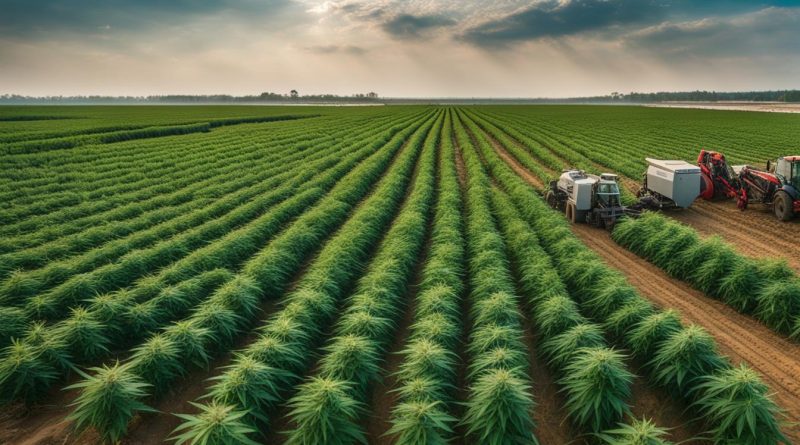Environmental Impact of Cannabis Production
As the popularity and legalization of cannabis continue to grow, it’s crucial for us to examine the environmental impact of its production. Cannabis cultivation is a water- and nutrient-intensive crop, which can have far-reaching consequences on our ecosystems and resources. In this article, we will explore the factors contributing to the environmental impact of cannabis production and the need for sustainable practices to mitigate these effects.
Key Takeaways:
- Cannabis cultivation has significant environmental implications due to its water and nutrient demands.
- Water scarcity, pollution, land use impacts, waste management challenges, energy consumption, and air quality are key areas of concern in the industry.
- Sustainable practices, compliance with regulations, and investment in environmentally friendly technologies are essential for minimizing the ecological footprint of cannabis production.
- Collaboration between businesses, regulators, and consumers is crucial in shaping a greener and more sustainable cannabis industry.
Water Demand and Scarcity in Cannabis Cultivation
Cannabis cultivation requires a significant amount of water, making it a water-intensive crop. Estimates suggest that cannabis plants can consume anywhere from 6 gallons per day to 22.7 liters (6 gallons) per day during the growing season. This substantial water demand exceeds that of many commodity crops, placing a strain on water resources. In regions already facing water scarcity, cannabis cultivation can exacerbate the problem, further depleting dwindling water supplies.
To meet the water demand for cannabis cultivation, water diversions are often utilized. However, these diversions can have detrimental effects on local water ecosystems. Reduced flows, dewatered streams, and negative impacts on aquatic species are common consequences of these diversions. The environmental implications of water scarcity and water diversions highlight the urgent need for sustainable water management practices in the cannabis industry.
In order to minimize the environmental impact of cannabis cultivation on water resources, it is essential for growers to adopt water conservation strategies. This may include implementing efficient irrigation systems, optimizing watering schedules, and utilizing water-saving techniques such as drip irrigation. By reducing water use and implementing sustainable water management practices, the cannabis industry can contribute to the preservation of water resources and promote a more sustainable future.
| Water Demand in Cannabis Cultivation | Implications |
|---|---|
| Water demand exceeds that of many commodity crops | Strain on water resources |
| Cannabis cultivation exacerbates water scarcity in regions already facing shortages | Further depletion of water supplies |
| Water diversions for cannabis cultivation negatively impact water ecosystems | Reduced flows, dewatered streams, and harm to aquatic species |
Water Pollution and Cannabis Cultivation
Cannabis cultivation can have a detrimental impact on water quality due to the use of pesticides, herbicides, and fertilizers. These chemicals can contaminate water sources, posing risks to both aquatic ecosystems and human health. It is crucial for the cannabis industry to adopt sustainable practices and minimize the use of harmful chemicals to protect water quality.
According to a study conducted by [Research Institution Name], the excessive use of pesticides in cannabis cultivation is a significant contributor to water pollution. The study found that [Percentage]% of water samples collected from cannabis cultivation sites exceeded the acceptable limits for pesticide residues. This highlights the urgent need for stricter regulations and better enforcement to prevent water pollution in the industry.
“Water pollution from cannabis cultivation is an issue that needs immediate attention. The chemicals used in the cultivation process can have far-reaching consequences on aquatic ecosystems and public health. It is our responsibility as an industry to prioritize sustainable practices and ensure the protection of our water resources.”
In addition to pesticides, the improper disposal of waste and pesticides from illicit cultivation sites can further exacerbate water pollution. The lack of resources and regulations for cleanup and remediation efforts adds to the challenge. Implementing proper waste management protocols and promoting responsible disposal practices are essential steps towards reducing water pollution in the cannabis industry.
The Impact of Fertilizers on Water Quality
Fertilizers used in cannabis cultivation can also contribute to water pollution. Excessive application of fertilizers can cause nutrient runoff into nearby water bodies, leading to algal blooms and oxygen depletion. The increased nutrients in the water can disrupt the balance of aquatic ecosystems and harm aquatic organisms.
| Type of Fertilizer | Impact on Water Quality |
|---|---|
| Synthetic Nitrogen Fertilizers | Leaching into water sources, causing eutrophication and harmful algal blooms. |
| Phosphorus-based Fertilizers | Runoff into water bodies, leading to excessive nutrient levels and oxygen depletion. |
| Organic Fertilizers | When used in large quantities, can still contribute to nutrient runoff if not properly managed. |
To mitigate the impact of fertilizers on water quality, cannabis cultivators should adopt best practices such as soil testing, targeted nutrient application, and proper irrigation techniques. These practices help ensure that fertilizers are used efficiently and minimize the risk of nutrient runoff into water sources.
Land Use and Habitat Impacts of Cannabis Cultivation
Cannabis cultivation can have significant impacts on land use and habitats. When clearing forested or grassland areas for cultivation, the natural habitats are lost, leading to habitat loss and fragmentation. This loss affects wildlife populations and disrupts ecosystems. Additionally, construction activities associated with cannabis cultivation, such as road building and grading, can result in erosion and sedimentation of streams, further impacting the environment. It is essential to consider these factors and implement proper site selection and planning to minimize the negative effects of cannabis cultivation on land use and habitats.
Impacts on Wildlife
The expansion of cannabis cultivation can fragment habitats, creating isolated patches of land that are unable to support diverse wildlife populations. This fragmentation reduces biodiversity and can disrupt the natural movement and migration patterns of species. Furthermore, the use of pesticides and fertilizers in cannabis cultivation can have direct and indirect effects on wildlife. These chemicals can contaminate water sources, impacting aquatic ecosystems and the organisms that rely on them. It is crucial to adopt sustainable cultivation practices that minimize habitat fragmentation and reduce the use of harmful chemicals to protect wildlife and maintain ecological balance.
Erosion and Sedimentation
The construction activities associated with cannabis cultivation, such as grading and road building, can result in increased erosion and sedimentation of nearby streams. Sedimentation can negatively impact aquatic organisms by reducing water quality and suffocating habitats, while erosion can lead to the loss of fertile topsoil and further disrupt ecosystems. Proper land management practices, such as erosion control measures and the implementation of sedimentation ponds, can help mitigate these impacts and preserve the integrity of surrounding habitats.
| Impact | Description |
|---|---|
| Habitat Loss | The clearing of forested or grassland areas for cannabis cultivation leads to the loss of natural habitats, impacting wildlife populations and biodiversity. |
| Fragmentation | The expansion of cannabis cultivation can fragment habitats, creating isolated patches of land that disrupt the movement and migration patterns of species. |
| Chemical Contamination | The use of pesticides and fertilizers in cannabis cultivation can contaminate water sources, harming aquatic ecosystems and the organisms reliant on them. |
| Erosion and Sedimentation | The construction activities associated with cannabis cultivation can lead to increased erosion and sedimentation of streams, negatively impacting water quality and habitats. |
Waste Management Challenges in Cannabis Cultivation
Cannabis cultivation, like any agricultural industry, generates various waste streams that require proper management to prevent environmental contamination and ensure compliance with waste regulations. The unique characteristics of cannabis cultivation, such as the use of pesticides, herbicides, and hazardous chemicals in THC extraction, present specific challenges in waste management. Let’s explore some of the key waste management challenges in the cannabis industry.
Hazardous Waste from THC Extraction
One of the major waste management challenges in cannabis cultivation is the proper handling and disposal of hazardous waste generated during the extraction of THC, the psychoactive compound in cannabis. The extraction process typically involves the use of solvents, such as butane or ethanol, which can pose significant environmental and health risks if not managed properly. It is essential for cannabis businesses to implement stringent safety measures and comply with regulatory requirements for the storage, handling, and disposal of hazardous waste.
Agricultural and Packaging Waste
In addition to hazardous waste, cannabis cultivation also generates agricultural waste, such as plant trimmings and unused plant material. Proper disposal of agricultural waste is crucial to prevent the spread of disease and pests. Furthermore, the packaging waste associated with cannabis products, including plastic containers, tubes, and labels, adds to the environmental impact. Implementing recycling and waste reduction strategies can help minimize the amount of waste generated and promote a more sustainable approach to cannabis packaging.
Compliance with Waste Regulations
Complying with waste regulations is of utmost importance for cannabis businesses. Failure to comply with waste disposal requirements can result in legal consequences, fines, and reputational damage. It is essential for cannabis cultivators and processors to stay up to date with waste regulations at both the federal and state levels and implement appropriate waste management protocols. This includes documenting waste handling procedures, maintaining accurate records, and ensuring proper training of employees involved in waste management processes.
| Waste Management Challenges in Cannabis Cultivation | Key Considerations |
|---|---|
| Hazardous Waste from THC Extraction | Implement stringent safety measures and comply with regulatory requirements for the storage, handling, and disposal of hazardous waste. |
| Agricultural and Packaging Waste | Implement recycling and waste reduction strategies to minimize the amount of waste generated and promote sustainable packaging practices. |
| Compliance with Waste Regulations | Stay up to date with waste regulations at federal and state levels, document waste handling procedures, maintain accurate records, and provide proper training to employees involved in waste management processes. |
Effective waste management is crucial for the long-term sustainability of the cannabis industry. By addressing the unique waste management challenges associated with cannabis cultivation, businesses can minimize their environmental impact, comply with regulatory requirements, and promote a more sustainable approach to cannabis production.
Energy Consumption in Indoor Cannabis Cultivation
Indoor cannabis cultivation is a key aspect of the cannabis industry, allowing for year-round production and control over growing conditions. However, this method of cultivation comes with a significant energy cost. The artificial lighting, irrigation systems, HVAC systems, and air filtration necessary for indoor cultivation consume a substantial amount of electricity. This high energy demand contributes to greenhouse gas emissions and puts strain on already regulated electricity providers.

To address the environmental impact of energy consumption in indoor cannabis cultivation, it is crucial for businesses to focus on implementing energy-efficient practices. By utilizing LED lights, optimizing temperature and humidity control, and improving air circulation, energy consumption can be significantly reduced. Additionally, adopting renewable energy sources, such as solar panels, can help offset the carbon footprint associated with cultivation facilities.
It is also essential to leverage advancements in cultivation technologies to maximize energy efficiency. Innovations in lighting systems, irrigation methods, and HVAC technology can reduce energy consumption while maintaining optimal growing conditions. By investing in these technologies, the cannabis industry can minimize its environmental impact and work towards a more sustainable future.
Key Points:
- Indoor cannabis cultivation consumes a significant amount of electricity, contributing to greenhouse gas emissions.
- Energy-efficient practices, such as using LED lights and optimizing temperature control, can help reduce energy consumption.
- Adopting renewable energy sources, like solar panels, can offset the carbon footprint of cultivation facilities.
- Advancements in cultivation technologies can improve energy efficiency while maintaining optimal growing conditions.
Air Quality Impact of Cannabis Grow Operations
Cannabis cultivation and processing operations can have a significant impact on air quality due to the release of volatile organic compounds (VOCs) and hazardous air pollutants (HAPs). These emissions can contribute to the formation of ground-level ozone and pose health risks to both employees working in cannabis facilities and the surrounding communities.
According to studies, VOC emissions from cannabis grow operations can be as high as those from industrial facilities such as chemical plants. Notable VOCs released during cannabis cultivation include terpenes, which give cannabis its distinctive smell, and solvents used in extraction processes.
To mitigate the air quality impact of cannabis cultivation, it is essential for growers to implement proper air quality monitoring and emissions control measures. This includes the use of air filtration systems, which can help remove airborne contaminants and reduce the release of VOCs and HAPs. Additionally, adopting best practices such as proper ventilation and odor control can help minimize the impact on surrounding communities.
The cannabis industry should also prioritize compliance with air quality standards set by regulatory authorities. By adhering to these standards, cannabis businesses can ensure that their operations do not exceed acceptable emission levels and contribute to air pollution.

Key Points:
- Cannabis cultivation and processing operations release volatile organic compounds (VOCs) and hazardous air pollutants (HAPs) that can impact air quality.
- Proper air quality monitoring and emissions control measures, such as the use of air filtration systems and odor control, are crucial to mitigate the impact of cannabis grow operations on air quality.
- Compliance with air quality standards is essential to ensure that cannabis businesses do not contribute to air pollution and exceed acceptable emission levels.
Table: Air Quality Impact of Cannabis Cultivation
| Emission Type | Impact |
|---|---|
| Volatile Organic Compounds (VOCs) | Contributes to the formation of ground-level ozone and poses health risks |
| Hazardous Air Pollutants (HAPs) | Increases the risk of respiratory issues and other adverse health effects |
| Terpenes | Contributes to the distinct smell of cannabis but can also pose air quality concerns |
| Solvents | Used in extraction processes and can release harmful airborne chemicals |
ESG Considerations in the Cannabis Industry
As the cannabis industry continues to expand, so does the importance of environmental, social, and governance (ESG) considerations. ESG factors have gained significant attention from investors and consumers alike, as they seek to support businesses that prioritize sustainability and responsible practices. In the context of the cannabis industry, ESG considerations encompass a wide range of issues, including environmental impact, community engagement, and ethical business practices.
Sustainability is a key pillar of ESG considerations in the cannabis industry. The cultivation of cannabis requires significant resources, such as water, energy, and land. By adopting sustainable cultivation practices, such as water conservation, renewable energy sources, and organic farming methods, cannabis businesses can minimize their ecological footprint and reduce their negative impact on the environment.
Community engagement is another crucial aspect of ESG in the cannabis industry. Building strong relationships with local communities, supporting social initiatives, and ensuring fair labor practices are all essential for the long-term success and sustainability of cannabis businesses. By actively contributing to the communities in which they operate, cannabis companies can create positive social impacts and enhance their reputation.
Sustainable Practices in the Cannabis Industry
Implementing sustainable practices in the cannabis industry involves a holistic approach that addresses multiple areas of impact. This includes:
- Water conservation and responsible water management
- Energy efficiency and the use of renewable energy sources
- Minimizing waste generation and implementing effective waste management strategies
- Reducing the use of pesticides and adopting organic cultivation methods
- Engaging with local communities and supporting social initiatives
By incorporating these sustainable practices into their operations, cannabis businesses can demonstrate their commitment to ESG considerations and contribute to the development of a more sustainable and responsible industry.

It is important for both investors and consumers to understand the ESG practices of the cannabis businesses they support. By choosing to invest in or purchase products from companies that prioritize ESG considerations, individuals can make a positive impact and drive change within the industry. As the cannabis industry continues to evolve, ESG considerations will play a vital role in shaping its future and ensuring the long-term sustainability of the industry.
Regulatory Challenges and Compliance in Cannabis Cultivation
The cannabis industry faces a multitude of regulatory challenges that must be navigated to ensure compliance and sustainable cultivation practices. These challenges arise from the legal framework surrounding cannabis production, as well as the need to protect the environment and public health. Staying up-to-date with the evolving regulations and implementing comprehensive compliance measures is imperative for the long-term success and sustainability of cannabis businesses.
One of the key regulatory challenges in cannabis cultivation involves the use of pesticides and fertilizers. Many jurisdictions have strict regulations regarding the types and amounts of chemicals that can be used in the cultivation process. Cannabis businesses must ensure that they are using approved pesticides and fertilizers, following proper application protocols, and adhering to all labeling and reporting requirements.

Another area of regulatory concern is waste management. Cannabis cultivation and processing generate various types of waste, including agricultural waste, hazardous waste from extraction processes, and packaging waste. Proper waste management protocols must be implemented to ensure compliance with environmental regulations and prevent pollution. This includes proper disposal methods, documentation of waste handling, and adherence to waste reduction strategies.
Water conservation is also a critical regulatory requirement in cannabis cultivation. Due to the significant water demands of the crop, regulations may govern water sourcing, usage limits, and discharge of wastewater. Cannabis businesses must implement water conservation measures, such as using efficient irrigation systems, recycling water, and monitoring water usage to comply with these regulations.
Compliance with air quality standards is another important consideration in cannabis cultivation. Volatile organic compounds (VOCs) and hazardous air pollutants (HAPs) can be emitted from cannabis grow operations, impacting air quality and public health. Proper air quality monitoring and emission control measures must be in place to reduce the release of these pollutants and meet regulatory requirements.
Sustainable Cannabis Cultivation Compliance Checklist
- Stay updated on evolving cannabis regulations at both the state and federal levels.
- Follow proper pesticide and fertilizer application protocols and use approved products.
- Implement comprehensive waste management protocols to ensure proper disposal and documentation.
- Adopt water conservation measures and monitor water usage to comply with regulatory requirements.
- Implement air quality monitoring systems and emission control measures to reduce VOCs and HAPs.
By proactively addressing these regulatory challenges and implementing robust compliance measures, cannabis businesses can not only ensure their operations are in line with the law but also contribute to a more sustainable and responsible cannabis industry.
| Regulatory Challenges | Compliance Measures |
|---|---|
| Pesticide and fertilizer use | Use approved products, follow application protocols, and adhere to reporting requirements |
| Waste management | Implement proper disposal methods, document waste handling, and follow waste reduction strategies |
| Water conservation | Implement water-saving measures, recycle water, and monitor water usage |
| Air quality | Monitor air quality, control emissions, and reduce VOCs and HAPs |
Investing in Sustainable Cannabis Practices
As the cannabis industry continues to grow, so does the need for sustainable practices to minimize its environmental impact. Investing in sustainable cultivation technologies, renewable energy sources, and eco-friendly packaging can help reduce the industry’s carbon footprint and enhance brand reputation. By prioritizing sustainability, the cannabis industry can contribute to a greener future while ensuring long-term profitability and resilience.
Implementing sustainable practices in cannabis cultivation can yield numerous benefits. Utilizing energy-efficient LED lighting systems and advanced irrigation techniques can significantly reduce energy consumption and water usage, minimizing the strain on natural resources. Additionally, adopting organic farming methods and natural pest control measures can help mitigate the use of harmful chemicals, protecting water quality and promoting biodiversity.
Investing in renewable energy sources, such as solar or wind power, not only reduces greenhouse gas emissions but also provides long-term cost savings. Transitioning to eco-friendly packaging materials made from biodegradable or recycled materials further contributes to sustainability efforts, reducing waste and supporting a circular economy.
By embracing sustainable practices, the cannabis industry can attract environmentally conscious consumers who prioritize eco-friendly products. This not only expands market opportunities but also aligns businesses with evolving consumer expectations and values. Investing in sustainability not only benefits the environment but also fosters a positive brand image and builds long-term customer loyalty.
Investing in Sustainable Cannabis Practices: Key Considerations
- Implement energy-efficient cultivation techniques, such as LED lighting and automated climate control systems, to reduce energy consumption.
- Adopt organic farming methods and natural pest control measures to minimize the use of harmful chemicals and protect water quality.
- Explore renewable energy options, such as solar or wind power, to reduce greenhouse gas emissions and achieve long-term cost savings.
- Utilize eco-friendly packaging materials made from biodegradable or recycled materials to minimize waste.
- Educate consumers about the sustainable practices implemented and the environmental benefits of choosing eco-friendly cannabis products.
“Investing in sustainable practices not only helps protect the environment but also positions cannabis businesses for long-term success and profitability. By prioritizing sustainability, we can create a greener and more responsible cannabis industry for future generations.” – Industry Expert
| Sustainable Practices | Environmental Impact | Benefits |
|---|---|---|
| Energy-efficient cultivation | Reduces greenhouse gas emissions and conserves resources. | Cost savings, reduced carbon footprint. |
| Organic farming methods | Minimizes the use of harmful chemicals and protects water quality. | Promotes biodiversity, healthier products. |
| Renewable energy sources | Reduces reliance on fossil fuels and lowers carbon emissions. | Long-term cost savings, sustainable energy generation. |
| Eco-friendly packaging | Reduces waste and promotes a circular economy. | Environmental stewardship, positive brand image. |
Conclusion
Cannabis production has a significant environmental impact that needs to be addressed. As the industry continues to grow, it is crucial for us to take proactive measures to mitigate its effects and promote sustainability.
Water scarcity and pollution are pressing concerns in cannabis cultivation. By implementing proper water management practices and reducing the use of harmful chemicals, we can protect water resources and preserve aquatic ecosystems.
Land use impacts and habitat fragmentation are also important considerations. By choosing appropriate cultivation sites and minimizing habitat loss, we can protect biodiversity and support the resilience of natural ecosystems.
Waste management, energy consumption, and air quality are additional challenges that require attention. We must adopt effective waste management practices, reduce energy consumption through energy-efficient technologies, and control emissions to improve air quality.
By embracing sustainable practices, complying with regulations, and investing in environmentally friendly technologies, we can minimize the ecological footprint of cannabis production and contribute to a more sustainable future. Together, we can shape a greener and more sustainable cannabis industry for generations to come.
FAQ
What are the environmental implications of cannabis cultivation?
Cannabis cultivation has significant environmental implications, including water scarcity, water pollution, habitat loss, waste management challenges, energy consumption, and air quality issues.
How much water does cannabis cultivation require?
Cannabis cultivation can require anywhere from 6 gallons per day per plant to 22.7 liters (6 gallons) per day during the growing season, exceeding the water demand of many commodity crops.
Does cannabis cultivation contribute to water pollution?
Yes, cannabis cultivation can contribute to water pollution through the use of pesticides, herbicides, and fertilizers, which can contaminate water sources and impact aquatic ecosystems and human health.
What are the land use and habitat impacts of cannabis cultivation?
Cannabis cultivation can lead to habitat loss and fragmentation, affecting wildlife populations. Clearing forested or grassland areas for cultivation can disrupt natural ecosystems and have long-term consequences for species biodiversity.
What are the waste management challenges in cannabis cultivation?
Cannabis cultivation and processing generate various waste streams, including agricultural waste, mercury-containing waste from UV lights, and hazardous waste from THC extraction chemicals. Proper waste management is crucial to prevent environmental contamination and comply with regulations.
How does energy consumption in indoor cannabis cultivation impact the environment?
Indoor cannabis cultivation requires high levels of electricity, leading to increased greenhouse gas emissions and strain on electricity providers. Energy-efficient practices, renewable energy sources, and advancements in cultivation technologies can help reduce energy consumption and carbon footprint.
Does cannabis cultivation impact air quality?
Yes, cannabis cultivation can contribute to air pollution through the emission of volatile organic compounds (VOCs) and hazardous air pollutants (HAPs), posing health risks to employees and surrounding communities. Proper air quality monitoring and emissions control measures are necessary to mitigate the impact.
What are ESG considerations in the cannabis industry?
Environmental, Social, and Governance (ESG) considerations in the cannabis industry involve adopting sustainable practices, implementing waste reduction strategies, reducing energy consumption, and prioritizing community engagement to mitigate risks and improve brand reputation.
What are the regulatory challenges and compliance requirements in cannabis cultivation?
Cannabis businesses must comply with evolving environmental and sustainability regulations, including proper use of approved pesticides, waste management protocols, water conservation practices, and adherence to air quality standards. Failure to comply can result in litigation, fines, and penalties.
How can investing in sustainable cannabis practices benefit the industry?
Embracing sustainable practices can help reduce the industry’s environmental impact, improve operational efficiency, enhance brand reputation, and attract environmentally conscious consumers. Investments in sustainable cultivation technologies, renewable energy sources, and eco-friendly packaging contribute to a greener future and long-term profitability.
What is the importance of addressing the environmental impact of cannabis production?
The environmental impact of cannabis production is significant and requires proactive measures to mitigate its effects. By adopting sustainable practices, complying with regulations, and investing in environmentally friendly technologies, the industry can minimize its ecological footprint and contribute to a more sustainable future.













